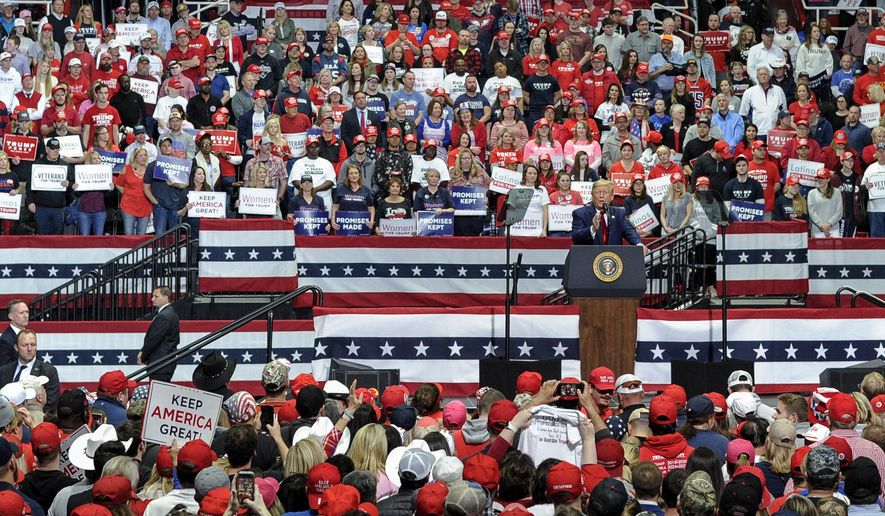WASHINGTON — After months away from the campaign trail, President Donald Trump plans to rally his supporters next Saturday for the first time since most of the country was shuttered by the coronavirus. But health experts are questioning that decision.
Trump will head to Tulsa, Oklahoma – a state that has seen relatively few COVID-19 cases. Yet the Tulsa City-County Health Department’s director told the Tulsa World over the weekend that he wished the Trump campaign would move the date back because of a “significant increase in our case trends.”
“I’m concerned about our ability to protect anyone who attends a large, indoor event, and I’m also concerned about our ability to ensure the president stays safe as well,” Dr. Bruce Dart told the newspaper.
Other health experts also cite the danger of infection spreading among the crowd and sparking outbreaks when people return to their homes. The Trump campaign itself acknowledges the risk in a waiver attendees must agree to absolving them of any responsibility should people get sick.
WHAT MAKES THE RALLY HIGH RISK?
Trump’s rally will be held indoors, at a 19,000-seat arena that has canceled all other events through the end of July. Scientists believe the virus spreads far more easily in crowded enclosed spaces than it does outdoors, where circulating air has a better chance of dispersing virus particles.
SEE ALSO: Brad Parscale says Trump Oklahoma rally ticket requests surpass 800,000
The Centers for Disease Control and Prevention outlines the highest risk events for transmission of the coronavirus this way: “Large in-person gatherings where it is difficult for individuals to remain spaced at least 6 feet apart and attendees travel from outside the local area.” The CDC recommends cloth masks in places where people might shout or chant.
Trump’s rallies typically draw tens of thousands of supporters. They usually stand outside in line for hours before passing through airport-style security and cramming into an arena, where they sit side by side or stand shoulder to shoulder. The rallies are typically raucous, with much shouting, cheering and chanting. Some people dance and jeer at reporters. Sometimes protesters are met with violence before they are removed by security.
Many attendees are older, which would put them at higher risk of severe complications from COVID-19. It’s not unusual for several individuals in the crowd to require medical attention when the temperature rises.
The rallies also typically draw supporters from surrounding towns and states. Some die-hard fans travel across the country from rally to rally like groupies for a band.
Dr. Ashish Jha, director of Harvard’s Global Health Institute, called the upcoming Trump rally “an extraordinarily dangerous move for the people participating and the people who may know them and love them and see them afterward.”
Trump supporters coming from neighboring cities and states could carry the virus back home, Jha said. “I’d feel the same way if Joe Biden were holding a rally.”
OKLAHOMA CASES LOW BUT RISING
In its final phase of reopening, Oklahoma now allows public gatherings of any size as long as organizers consider social distancing. Participants at any large gathering should stay 6 feet (1.8 meters) apart and wear a cloth face covering when distancing is a challenge, the state health department said.
The state has a relatively low death rate compared with the rest of the nation, but new cases are rising. In Tulsa, there were 82 new cases reported Saturday, a new high in daily increases for the county. The Tulsa Health Department already was investigating an outbreak linked to an indoor gathering of a large group of people.
Citing the spike in cases, Dart said he wished the rally would postponed to a later date “when the virus isn’t as large a concern as it is today.”
“I think it’s an honor for Tulsa to have a sitting president want to come and visit our community, but not during a pandemic,” Dart said in an interview Saturday with the Tulsa World.
Dart said the risk of spreading the virus increases with higher numbers of people congregating for longer periods of time.
Oklahoma health authorities said that anyone who attends a large public event should get tested for COVID-19 shortly afterward.
Shelley Payne, director of the LaMontagne Center for Infectious Disease at the University of Texas at Austin, said the Trump rally meets every criteria for the riskiest type of event.
“I would certainly recommend that people wear masks and try to keep as much distance as possible,” Payne said.
Julie Fischer, an associate research professor of microbiology and immunology at Georgetown University, said the event could have wide repercussions for the country.
“With a little bad luck, that scenario could end in the seeding of community outbreaks of COVID-19 across the U.S.,” she said.




Please read our comment policy before commenting.